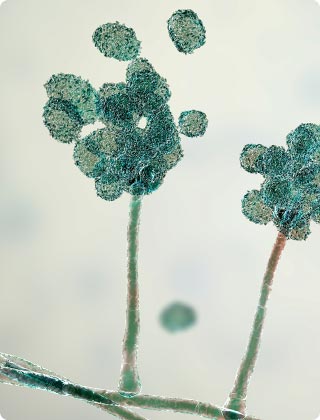
7 Surprising Facts About Black Mold (Stachybotrys chartarum)
Did you know that not all black mold is actually black - or even toxic?
When most people hear the words black mold, they imagine a dangerous, fast-spreading fungus that can take over a home and make everyone sick. While there's some truth to that, the reality is more complex and more surprising.
In this post, O2 Mold Testing will uncover 7 lesser-known facts about Stachybotrys chartarum (commonly called black mold) that every homeowner should know. Whether you're dealing with a musty smell in your basement or just want to protect your family's health, these facts will help you understand what you're really up against.
Fact 1: Black Mold Isn't Actually Black
Despite its ominous name, Stachybotrys chartarum isn't always black. In fact, it often appears greenish-black, dark gray, or even slightly brown, depending on the surface it's growing on and how long it's been there.
This is one of the biggest reasons homeowners misidentify mold. Many types of mold, including Cladosporium and Aspergillus, can also appear dark or black, but they're not the same as Stachybotrys chartarum. Not all dark-looking mold has the same health risks.
Why it matters:
If you see dark mold in your home, don't assume it's the "toxic black mold" you've heard about, but don't ignore it either. The only way to know for sure is through professional mold testing.
Fact 2: It Grows on Wet, Cellulose-Rich Materials
Black mold doesn't just grow anywhere - it's picky. Stachybotrys chartarum thrives on materials that contain cellulose, such as:
- Drywall
- Wood framing
- Ceiling tiles
- Wallpaper
- Insulation
But there's a catch: it also needs constant moisture. That's why it's often found in places with water damage, like after a flood, a roof leak, or a plumbing issue that wasn't fixed quickly.
Why it matters:
If your home recently experienced a leak or flood, even if it was months ago, and the area wasn't properly dried, it could be the perfect breeding ground for black mold. Just because the surface looks dry now doesn't mean the mold isn't growing underneath, and you don't need a mold inspection service right away.
Fact 3: It Needs Constant Moisture to Survive
Unlike some molds that can go dormant and reactivate later, Stachybotrys chartarum needs continuous moisture to grow and stay active. It doesn't just appear overnight - it takes time, and it thrives in persistently damp environments.
That's why black mold is often found in places like:
- Leaky basements
- Bathrooms with poor ventilation
- Behind walls after pipe bursts
- Under floors after flooding
If the moisture source isn't fixed, the mold problem will only keep spreading further.
Why it matters:
Wiping away visible mold isn't enough. If the moisture problem isn't addressed, the mold will come back, and possibly worse than before. That's why moisture control is mold control.
Fact 4: It Can Produce Harmful Mycotoxins - But Not Always
One of the reasons black mold gets so much attention is because it can produce mycotoxins - toxic compounds that may affect human health. These toxins are released when the mold is actively growing and under stress, such as when it's competing with other microbes or disturbed.
Exposure to these mycotoxins can lead to symptoms like
- Chronic coughing or sneezing
- Eye, nose, and throat irritation
- Skin rashes
- Fatigue or headaches
However, not all Stachybotrys chartarum colonies produce toxins, and not everyone reacts the same way.
"Exposure to damp and moldy environments may cause a variety of health effects, or none at all. For some people, mold can cause a stuffy nose, sore throat, coughing or wheezing, burning eyes, or skin rash." - Centers for Disease Control and Prevention (CDC)
Why it matters:
Just because you don't feel sick doesn't mean the mold isn't harmful, and just because it's black doesn't mean it's toxic. The only way to know for sure is through lab testing by a certified mold inspector.
Fact 5: It's Often Hidden - and Smells Before It's Seen
One of the most frustrating things about black mold is that it often grows where you can't see it. It loves dark, damp, and undisturbed spaces, like:
- Behind drywall
- Under carpets or floorboards
- Inside HVAC systems
- Behind bathroom tiles
In many cases, the first sign isn't visual - it's a smell. A persistent, musty odor that doesn't go away with cleaning could be a red flag that mold is growing out of sight.
Why it matters:
If you smell something musty but can't find the source, don't ignore it. Mold can cause damage long before it becomes visible. A professional mold inspection can detect hidden growth using moisture meters, infrared cameras, and air sampling.
Fact 6: Not All Black-Colored Mold Is Toxic
Just because mold looks black doesn't mean it's Stachybotrys chartarum, and it doesn't automatically mean it's dangerous. Many other mold species, like Cladosporium or Alternaria, can also appear dark or black but don't produce the same toxins.
In fact, some harmless molds can look more threatening than toxic ones. That's why color alone is not a reliable way to identify mold.
Why it matters:
Relying on appearance can lead to false alarms. The only way to know what kind of mold you're dealing with is through lab testing by a certified mold professional.
Fact 7: Professional Mold Testing Is the Only Way to Be Sure
You can't always see mold. You can't always smell it. And you definitely can't identify it by color alone. That's why in case you need to know how to detect black mold, the most reliable way is to get professional help.
Certified mold inspectors use tools like:
- Air sampling to detect airborne spores
- Surface swabs for lab analysis
- Moisture meters and infrared cameras to find hidden growth
These methods don't just confirm the presence of mold, they identify the exact species and help determine whether it's producing harmful toxins.
Why it matters:
Guessing can lead to unnecessary panic, or worse, ignoring a serious problem. Professional testing gives you clarity, peace of mind, and a clear plan of action.
Know the Facts, Protect Your Home
Black mold (Stachybotrys chartarum) is one of the most misunderstood threats in the home, and now you know why. From its misleading color to its need for constant moisture and its potential to produce harmful toxins, it's clear that black mold deserves serious attention.
But here's the good news: you don't have to panic, you just need to be informed. By understanding these 7 surprising facts, you're already ahead of the curve. And if you ever suspect mold in your home, the smartest move is to get it tested by professionals.
Take action today:
Suspect a mold problem? Don't guess. Get a definitive answer with professional mold testing from O2 Mold Testing. Our certified inspectors use advanced tools to detect, identify, and guide you through the next steps, giving you the peace of mind you deserve.


